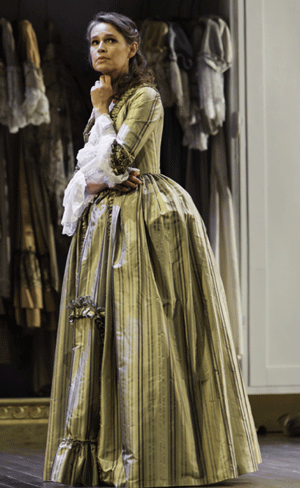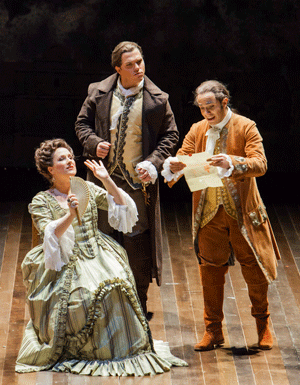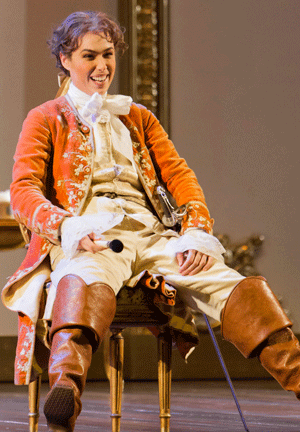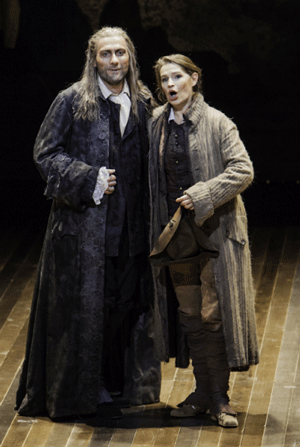The Divine Miss D immediately serves notice that she has no current equal in
this repertoire, singing with a pristine beauty of tone, displaying effortless
coloratura effects, and effectively modulating her beautifully limpid soprano
from full-bodied forte to hushed pianissimo and all points in between.
Moreover, Diana is a consummate stage creature who is capable of fully
investing the character of the scheming coquette with endlessly inventive stage
movement and business.
 Sophie Koch as Mignon
Sophie Koch as Mignon
Ms. Damrau not only boasts one of the most technically secure instruments in
the business, she also has that elusive star quality that makes us unable to
take our eyes off of her, with our ears joyously coming along for the ride.
While it is no surprise that she crafts “Je suis Titania”
as a veritable Masters Class in poised vocal perfection, the truth is that
she makes nary a false move the entire evening. If Thomas were alive, he would
most certainly write her back on stage in Act Three! Petite in physical stature
perhaps, but Diana Damrau’s Philine is a towering artistic achievement that
had me from “Bon jour.”
But the piece is called Mignon after all, and here too, Geneva cast
from strength. One of the most celebrated (and busiest) French mezzos of our
time, Sophie Koch gifted us with a deeply felt, wholly engaging performance.
Her refined lyric voice has a hint of a dusky hue to it, and Ms. Koch is quite
expert at crafting affecting plangent phrases. “Connais-tu le pays” was
polished and poised, touching yet avoiding bathos. She also made Act Three her
own with a solid understanding of the soft-edged dramatic and musical momentum.
Time and further experience with the character will likely lead this gifted
performer beyond the somewhat generic to a more nuanced approach, by
discovering a bit more variety that could be mined from the part. And she will
no doubt refine the few phrase endings that lost focus or were characterized by
a frayed release. Still, Sophie’s dramatic commitment was believably sincere,
and she skillfully deployed her mezzo with admirable results.
 Diana Damrau as Philine, Paolo Fanale as Wilhelm Meister and Emilio Pons as LaÎrte
Diana Damrau as Philine, Paolo Fanale as Wilhelm Meister and Emilio Pons as LaÎrte
Paolo Fanale showed great promise as Wilhelm Meister. When Mr. Fanale sings
at mezzo forte he impresses mightily with as creamy a lyric tenor as
you are likely to hear. He also offers some superlative diminuendo
effects that are cleanly executed. His upper range rings out freely and with
amplitude well above the staff. However, at louder volumes in mid- and
upper-range I had the impression that he was more forcing the placement into
the mask than allowing it to simply be in the mask.
This is not to say it was unpleasant to the listener, but rather a bit
worrisome for his future vocal health. Paolo is young, handsome, musical, and
is possessed of a naturally glowing tenor. He is needed. While his Meister had
much to recommend it, I would urge him to fine tune his vocal approach and
liberate the tonal production in the passaggio. If more French opera
is in his future, he might also be more attentive to his diction and nurture
more comfort with the language.
Nicolas Courjal earned one of the biggest ovations of the night for his
masterful Lothario. His gently throbbing vibrato and slightly grainy
bass-baritone were perfectly matched to the rangy vocal lines of this highly
sympathetic personage. Mr. Courjal was able to spin some flawless messa di
voce effects and pour out any number of well-judged legato
phrasings with a refinement that is not all that commonly encountered in this
Fach.
Emilio Pons made his usual fine impression in the small-but-important role
of LaÈrte. Mr. Pons was luxury casting, not only showing off an even, easily
produced tenor of good ping and presence, but also declaiming some of the most
idiomatic French dialogue of the cast, vivid and characterful. Emilio clearly
relished his conspiratorial scene work with Diana’s Philine, who created real
sparks as they prodded each other to ever more animated machinations.
 Carine SÈchaye as FrÈdÈric
Carine SÈchaye as FrÈdÈric
Carine SÈchaye had lots of fun with her goofy take on FrÈdÈric. Her
slightly steely mezzo had style and spunk, and her comic invention invested
this suitor with a decidedly fresh perspective. As the meanie Jarno, FrÈdÈric
Goncalves avoided dramatic clichÈ and sang with an assured, virile baritone.
In the inserted, mute role of the Servant, comic actor Laurent Delvert scored
some good laughs as he set up ‘audience’ seating for the gypsy show during
the overture’s Polonaise. The chairs were slid forcefully on stage on their
backs from the wings, coming in ever-greater numbers and speed. Just as he
finally got them all set up stage left, he suddenly realizes they should in
fact be stage right. In a burst of manic madness he moved them all to the other
side as the band played the frenetic finale.
Would that all of the stage direction had been similarly inspired. On the
plus side director Jean-Louis BenoÓt did not get in the way of his first rate
cast. Nor, however, did he add too much that was inventive or creative. He did
manage the traffic well enough, groupings were clean and focused, and principal
characters were never upstaged by irrelevant movement. Nor did the actors
always seem to be fully connected, as Mr. BenoÓt was content to have them sing
to us rather than each other, which was especially noticeable with Mignon and
Wilhelm in Act Three.
While this did enable the singing to be heard to maximum effect, it did
weaken the dramatic involvement in a piece that would benefit from more fully
involved character interaction. “Je suis Titania” began with a very
effective visual “build” which started with Philine on a platform up center
and had her moving incrementally to the apron flanked by the chorus. But then
the soprano was made to return way upstage for the finale, a visual, if not
vocal retreat. The director might reconsider and let his star shine down stage
through the end of the aria.
 Nicolas Courjal as Lothario and Sophie Koch as Mignon
Nicolas Courjal as Lothario and Sophie Koch as Mignon
Laurent Peduzzi’s sets were not particularly detailed nor meant to be, but
at least they did not distract. A false proscenium here, a drape there, a lone
bed at one point, a sole armoire at another, all were carefully chosen and the
whole was quite nicely showcased by Dominique BruguiÈre’s well-judged
lighting design.
The real design achievements of this production were the lavish, richly
detailed period court costumes by Thibaut Welchlin. Too, the fanciful
Shakespearean get-ups for A Midsummer Night’s Dream were
delightfully eye-catching. What a shame then that this accomplished costumer
made the miscalculation of dressing the title role in a well tailored man’s
suit for her entrance (clambering out of a clothes hamper no less). Instead of
looking like a somewhat androgynous, enigmatic gypsy girl, the lovely and
statuesque Ms. Koch looked instead like Octavian wandered in from a bus and
truck tour of Rosenkavalier. Mignon was thereby handicapped with
attire that made her look more hangdog teenaged boy than melancholy love struck
waif. And it made hash of the script’s requirement that Meister subsequently
demand that Mignon indeed disguise herself as a man servant. Huh?
In the pit, FrÈdÈric Chaslin made a strong case that he may just be the
world’s leading conductor of this repertoire. The splendid Orchestre de la
Suisse Romande collaborated with the Maestro to produce a reading that featured
delicately refined solo work, richly rendered ensemble passages, and
tremendously detailed layers of instrumental colors. The elegant harp solos
alone were worth the price of admission. The chorus was meticulously prepared,
tightly focused, and vibrantly emotive. Mr. Chaslin has elicited as persuasive
a rendition of this gentle character study as will likely ever be heard, with
an overall propulsive arc that was marvelously sustained for the entire
evening.
Mignon’s starry cast, credible design elements, competent
direction and superior musical values total up to a world-class opera-going
experience.
James Sohre
image=http://www.operatoday.com/Mignon_GTG_02.gif
image_description=Diana Damrau as Philine [Photo by GTG / Yunus Durukan]
product=yes
product_title=Ambroise: Thomas: Mignon
product_by=Mignon: Sophie Koch; Wilhelm Meister: Paolo Fanale; Philine: Diana Damrau; Lothario: Nicolas Courjal; FrÈdÈric: Carine SÈchaye; LaÈrte: Emilio Pons; Jarno: FrÈdÈric Goncalves; Servant: Laurent Delvert; Conductor: FrÈdÈric Chaslin; Director: Jean-Louis BenoÓt; Set Design: Laurent Peduzzi; Costume Design: Thibaut Welchlin; Lighting Design: Dominique BruguiÈre; Choreography: Lionel Hoche; Orchestre de la Suisse Romande
product_id=Above Diana Damrau as Philine
Photos by GTG / Yunus Durukan